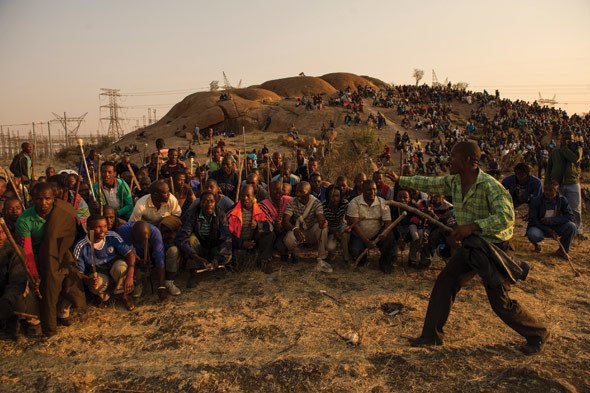Remember Marikana - eruption of a dormant volcano
22 September 2014
Two years after police mowed down striking mineworkers at Lonmin's Marikana mine near Rustenburg, Professor Sakhela Buhlungu - a widely cited scholar of South Africa's labour movements and mining industry - reflected on a system that marginalises the poorest workers at nearly every turn.
Police opened fire with live ammunition on striking mineworkers on 16 August 2012, killing 34 of the workers and injuring 78, in the denouement of a week of strikes that had already seen the loss of 10 lives (six miners, two police officers and two security guards). The massacre ignited furious debate about who was to blame; and at the time of writing, the Farlam Commission continues to dig for answers. While Marikana shocked many, Buhlungu suggests that this kind of incident has loomed like a dormant volcano over the labour landscape of post-apartheid South Africa for ages.
"Could it be that we never saw this coming? It's now two years since the brutal killings of Marikana at Lonmin's mine near Rustenburg; and of course, as we are gathered here to remember that gruesome episode in the second decade of post-apartheid South Africa, it's important that we pause and think about [and] make sense of it. What does it mean?"
In his lecture, titled Marikana 2012: Ghosts of the past and bitter fruits of liberation, Buhlungu addressed the incident from four different perspectives: as someone who grew up with families of mineworkers (his own father worked in the mines); as an activist with a strong background in the trade unions; as a scholar; and as a citizen of South Africa.
Mines, miners and miners' families
Growing up in a village where "every second household" had someone who left to work on the mines, Buhlungu recalled the impact of the mines on daily life being pervasive.
"[The mines] dictated the daily rhythm of life – down to the spacing of the children," he said, explaining that most siblings were born about three years apart and had birthdays around September and October - aligned to times when migrant workers returned home to their families.
The mines' hold on his community felt "normal". Similarly typical was for mineworkers to return home disabled, or "as corpses". When a breadwinner was lost, schoolboys often abandoned the classroom to take his place.
Buhlungu stressed that mineworkers in South Africa die on the job regularly - they're either murdered or fall victim to the job's inherent dangers. Marikana simply compressed this hazardous lifestyle into one big, gruesome incident.
"Think of the impact [of this massacre] on the children who now have to leave school," said Buhlungu.
History repeated
Some compared Marikana to the Soweto uprising of 1976 and the Sharpeville massacre of 1961, but Buhlungu digs further back in South Africa's history."For me, the comparison is [with] the white mineworkers' strike in 1922."
That year, said Buhlungu, the Smuts government "sided with capital". Mine owners had reneged on agreements with miners, and teamed with Smuts to "squeeze the mineworkers".
"The workers took up arms, and they were mowed down using the air force.
"For me, that's the comparison. Your Smuts of today is Jacob Zuma, and of course your capital of today is Cyril Ramaphosa and others at Lonmin."
Cheap labour: here to stay?
But for Buhlungu, Marikana also represents something deeper and more systemic.
"The overarching story of Marikana - and this is the story we're not talking about - is that the cheap labour system has remained intact in this country. Completely intact. If you look at pay scales - it doesn't matter what industry - those of us who sit at the higher end of it all benefit from it, because there's just no logic that explains the gap.
"So, yes, it's to protect profits, but also because R12 500 [the salary that workers at Marikana were demanding] begins to question, head-on, the cheap labour system. And that's one debate that we really need to have - how do we get out of the cycle of the cheap labour system in this country?"
The massacre at Marikana, Buhlungu lamented, showed that we have a government saying "that the cheap labour system is going nowhere".
Sold out
Cyril Ramaphosa co-founded the National Union of Mineworkers (NUM) in the 1980s, a decade during which it oversaw the then-biggest strike in South Africa's history. In 2012, said Buhlungu, Ramaphosa and NUM were another two festering wounds that made a massacre like the one at Marikana almost "inevitable".
NUM was growing increasingly aloof towards its constituency; its leaders were pocketing huge salaries (paid by the mining companies), while the workers they were meant to represent struggled to survive, said Buhlungu.
Lonmin's rock drillers at the Marikana mine only resorted to an independent and unprotected strike when NUM dithered after being asked to take workers' concerns to the mine's management. This alienation - of workers from their unions - can be seen throughout the present organised labour movement in South Africa, which Buhlungu described as "rotten to the core".
Ramaphosa, too, represents an underlying fissure in the post-apartheid structure that South Africa seems reluctant to talk about - with devastating consequences: that of the sell-out.
Ramaphosa, the former firebrand union leader - who in 2012 owned shares in Lonmin, and who continues to rise in the ranks of ruling African National Congress (ANC) - embodies the idea of struggle heroes who seem to have sacrificed the popular struggle for personal gain, said the dean. "Marikana is, for me, quintessentially [about] the sell-out. Cyril Ramaphosa is part of that sell-out. It's not as simple as [saying] the nationalist movement sells out and the socialist movement doesn't sell out – The sell-out is when the militarised section of the police force is used to mow people down in broad daylight."
Dehumanising language
Buhlungu condemned some of the discourse around Marikana, including the idea that it was a 'tragedy' - only the "very, very cynical in our society" could still call it a tragedy, and not a massacre - as well as the inordinate number of column inches devoted to chatter about the miners using muti to protect themselves in the lead-up to the shooting.
"Some academics have questioned the muti thing. Good gracious me. Politicians use muti every day. It's part of the idiom in those communities - but when it's mineworkers, it's 'out there'."
This mirrored a global trend to dehumanise workers and oppressed people, in an attempt to make their plight more palatable to an urban middle-class audience.
Mineworkers in South Africa bore the major brunt of this, and the intersection of class prejudices and abject working and living conditions renders them still the "most despised" workers in the country, said Buhlungu.
"In a way, I'm saying that there's a need for us to understand mineworkers as normal human beings."
Deadly brew
This complex concoction of factors could have resulted in a Marikana-esque bloodbath earlier in 2012, said Buhlungu. Miners went on strike at Impala Platinum's Rustenburg plant in February that year, and Buhlungu said the clashes between police and the miners - riddled with rubber bullets - could easily have deteriorated into something deadlier.
Buhlungu reserved a word for scholars of the labour and mining fields.
"I've always been struck by and concerned about how little we as researchers - not only in terms of mining, but also of the labour movement - understand about that world; how we skim the surface, how we come up with this caricature of 'the worker'."
Professor Dunbar Moodie, author of the seminal work Going for Gold: Men, Mines and Migration, was a scholar who knew the mining world deeply, said Buhlungu. The dean urged fellow researchers to aspire to a similarly deep understanding instead of settling for quick, "dirty" articles that are published in prestigious international journals largely because of their "novelty factor".
In the end, Buhlungu suggests, a first step to healing the sick system that produced the massacre at Marikana would be to re-read the work of Frantz Fanon, who wrote extensively about colonisation, decolonisation and the struggle for a just post-liberation society.
Story by Yusuf Omar. Photo by Greg Marinovich.
 This work is licensed under a Creative Commons Attribution-NoDerivatives 4.0 International License.
This work is licensed under a Creative Commons Attribution-NoDerivatives 4.0 International License.
Please view the republishing articles page for more information.
Faculty Focus - Commerce
Books
News
Front page
Previous Editions










